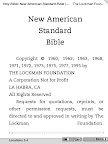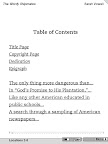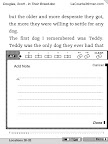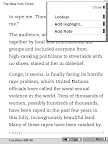After about 30 seconds of reading a book on the Kindle, you forget you are even reading a book on a digital device.
The first book I bought was the Bible; it helped me get over the guilt of spending nearly 400 dollars on a
eReader! I expected this to take awhile, but, surprisingly, it download just as quick as any other book (30 seconds are less is pretty normal). Obviously, this is one book where navigation is important; with a simple click (no matter where you are) you can go to the Table of Contents page; here you can select the book, and then chapter you are looking for. All books work the same way. This is nice for most books...others, such as Sarah
Vowell's The Wordy Shipmates, it's a little confusing, because her book doesn't have chapters; you can see in the image below how this becomes difficult, but not impossible, to find your place. Luckily, whenever you stop reading, it automatically remembers where you were in every single book.
Another nice thing about the Kindle is you can erase your books to save space, and then
re download them at a later time; unlike basically all MP3 stores, which make you buy the song again if you delete it, Amazon keeps a copy of it online for you.
The built in dictionary is a bit sluggish, but easy to get to. Whenever you are stuck on a word and want to know what it means, simply click the scroll, click look up, and the Kindle looks up every single word on the line you have pointed at; it takes about 10 to 20 seconds to return the results; it still beats digging up your dictionary to find the definition.
You also have the ability to highlight and take notes on a particular passage; I haven't played around with this much, but I imagine it would be great for college students who have put textbooks on their Kindles. Typing on the Kindle has a bit of a delay, which I don't mind too much; it would bug me if I was using it to type a term paper, but when all your doing is typing in
web pages and book titles, you hardly even notice.










5 comments:
I would be interested to hear during your review this week on how libraries might use Kindles - would it be more suitable for in library use of reference materials, for checkout of fiction, for reserves of textbooks, etc. I downloaded the CIA World Factbook on our library's new Kindle (not being used by patrons) and was disappointed to find that I could not search the full text of the book. I wonder if searching a book depends on the title or if that is just a feature that is not a part of Kindle books.
Actually there is a search. On the keypad you just hit "search," type the word, and it will search every single book on your Kindle for that word and show many how many times in each book the work is used.
As far as Kindle in the library...I'm not sure; for newspapers I think it's a great idea. The subscription is actually cheaper then a printed version, and no one steals them. I still like books on the bookshelf...nothing beats browsing for a book that's on the shelf.
I don't think the Kindle is really appropriate for libraries since the books, etc. are licensed to a single user only and are not really supposed to be shared.
One limitation of the dictionary is that you can't get too exotic. I've been reading War and Peace, which I downloaded many months ago and occasionally run across a word (usually military) which I don't know. The Kindle dictionary does not provide definitions of such words.
Another thing I really thinks needs improvement is the way you "turn the pages." It's much too easy to hit the bar to turn the page since it takes up almost the entire right side of the device and about a third of the left side. The on-off switch is also a bit out of the way (on the back) especially when you are using the leather cover.
My husband and I both own Kindles; we absolutely adore them and I take mine everywhere. When I broke my leg yesterday morning, the staff at my library bought me a bag for my Kindle so I can still carry it around while using crutches!
As for using it in a library setting...I can't see that working out very well for several reasons. While you can attach up to six Kindles to an account, and share books on those Kindles, you also have to have the One-click purchasing turned on. Library borrowers could buy whatever they wanted, without approval, whenever they checked out a Kindle. Also, say you buy 100 Kindle books, but only have five Kindles. That puts 100 books in the hands of five borrowers. It makes more sense from a collection development standpoint to buy 100 books that could, potentially, serve 100 borrowers at a time.
You never know...maybe Amazon will work with libraries in the future; it's great brand exposure for them. For now, I think libraries could put magazines and newspapers on them, and let patrons check them out for use in the library only. $120 bucks for a year subscription to the LA Times is cheaper then buying a printed subscription.
Post a Comment